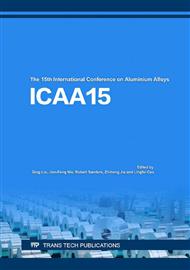[1]
Q.Y. Wang, N. Kawagoishi, Q. Chen, R.M. Pidaparti, Evaluation of the probability distribution of pitting corrosion fatigue life in aircraft materials, Acta Mech. Sinica, 19 (2003) 247-252.
DOI: 10.1007/bf02484487
Google Scholar
[2]
D.Z. Yu, Y.L. Chen, C.M. Duan, Statistical study on corrosion damage distribution of aircraft structure based on neural network, J. Chin. Soc. Corr. Pro., 26 (2006) 19-21. (in Chinese).
Google Scholar
[3]
Y.L. Chen, G.Z. Lv, C.M. Duan, A quantitative model for prediction of corrosion damage of engineering components based on neural network, J. Northwestern Polytechnical University, 20 (2002) 368-372. (in Chinese).
Google Scholar
[4]
W.F. Wu, C.C. Ni. Probabilistic models of fatigue crack propagation and their experimental verification, Probabilistic Eng. Mech., 19 (2004) 247-257.
DOI: 10.1016/j.probengmech.2004.02.008
Google Scholar
[5]
J. Saunier, M. Dymitrowska, A. Chausse, J. Stafiej, J.P. Badiali, Diffusion, interactions and universal behavior in a corrosion growth model, J. Electroanal. Chem., 582 (2005) 267-273.
DOI: 10.1016/j.jelechem.2005.03.047
Google Scholar
[6]
B. Malki, B. Baroux, Computer simulation of the corrosion pit growth, Corros. Sci., 47 (2005) 171-182.
DOI: 10.1016/j.corsci.2004.05.004
Google Scholar
[7]
R.M. Pidaparti, L. Fang, M.J. Palakal, Computational simulation of multipit corrosion process in materials, Comput. Mater. Sci., 41 (2008) 255-265.
DOI: 10.1016/j.commatsci.2007.04.017
Google Scholar
[8]
H. Wang, G.Z. Lv, L. Wang, Y.H. Zhang, Cellular Automaton Simulations of Surface Corrosion Damage Evolution, Acta Aeronautica et Astronautica Sinica, 29 (2008) 1490-1496. (in Chinese).
Google Scholar
[9]
N. Murer, R.G. Buchheit, Stochastic modeling of pitting corrosion in aluminum alloys, Corros. Sci., 69 (2013) 139-148.
DOI: 10.1016/j.corsci.2012.11.034
Google Scholar
[10]
L.R. He, Z.P. Yin, Q.Q. Huang, J.P. Liu, Simulation of local corrosion on metal surface with CA method, J. Aeronautical Mater., 35 (2015) 54-63. (in Chinese).
Google Scholar
[11]
R.J. Rioja, Fabrication methods to manufacture isotropic Al-Li alloys and products for space and aerospace applications, Mater. Sci. Eng. A, 257 (1998) 100-107.
DOI: 10.1016/s0921-5093(98)00827-2
Google Scholar
[12]
N.P. Gurao, A.O. Adesola, A.G. Odeshi, J.A. Szpunar, On the evolution of heterogeneous microstructure and microtexture in impacted aluminum-lithium alloy, J. Alloys Compd., 578 (2013) 183-187.
DOI: 10.1016/j.jallcom.2013.04.176
Google Scholar
[13]
C. Gao, Y. Luan, J.C. Yu, Y. Ma, Effect of thermo-mechanical treatment process on microstructure and mechanical properties of 2A97 Al-Li alloy, Trans. Nonferrous Met. Soc. China, 24 (2014) 2196-2202.
DOI: 10.1016/s1003-6326(14)63332-x
Google Scholar
[14]
A. Dattilo, S. Tamiro, C. Romano, Anodizing process, with low environmental impact, for a woodpiece of aluminum or aluminum alloys, United States Patent Application, 20020157961 (2002).
Google Scholar
[15]
P.G. Sheasby, R. Pinner, The surface treatment and finishing of aluminum and its alloys, Sixth ed., ASM international, Materials Park, Ohio, (2001).
Google Scholar
[16]
Y. Ma, X. Zhou, G.E. Thompson, M. Curioni, T. Hashimoto, P. Skeldon, P. Thomson, M. Fowles, Anodic film formation on AA2099-T8 aluminium alloy in tartaric-sulphuric acid, J. Electrochem., Soc. 158 (2011) C17-C22.
DOI: 10.1149/1.3523262
Google Scholar
[17]
Y. Ma, X. Zhou, G.E. Thompson, M. Curioni, X. Zhong, E. Koroleva, P. Skeldon, P. Thomson, M. Fowles, Discontinuities in the porous anodic film formed on AA2099-T8 aluminium alloy, Corros. Sci., 53 (2011) 4141-4151.
DOI: 10.1016/j.corsci.2011.08.023
Google Scholar
[18]
Y. Ma, X. Chen, X. Zhou, Y. Yi, Y. Liao, W. Huang, Microstructural origin of localized corrosion in anodised AA2099-T8 aluminium-lithium alloy, Surf. Interface Anal. DOI: 10. 1002/sia. 5856 (2015).
DOI: 10.1002/sia.5856
Google Scholar
[19]
Y. Ma, X. Zhou, G.E. Thompson, T. Hashimoto, P. Thomson, M. Fowles, Distribution of Intermetallics in an AA 2099-T8 Aluminium Alloy Extrusion, Mater. Chem. Phys., 126 (2011) 46-53.
DOI: 10.1016/j.matchemphys.2010.12.014
Google Scholar
[20]
J.O.M. Bockris, Lj.V. Minevski, On the mechanism of the passivity of aluminum and aluminum alloys, J. Electroanal. Chem., 349 (1993)375-414.
DOI: 10.1016/0022-0728(93)80186-l
Google Scholar


